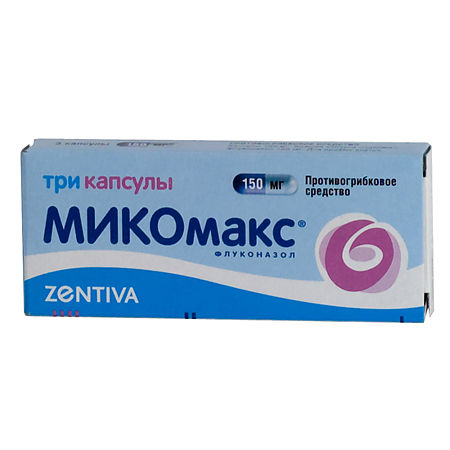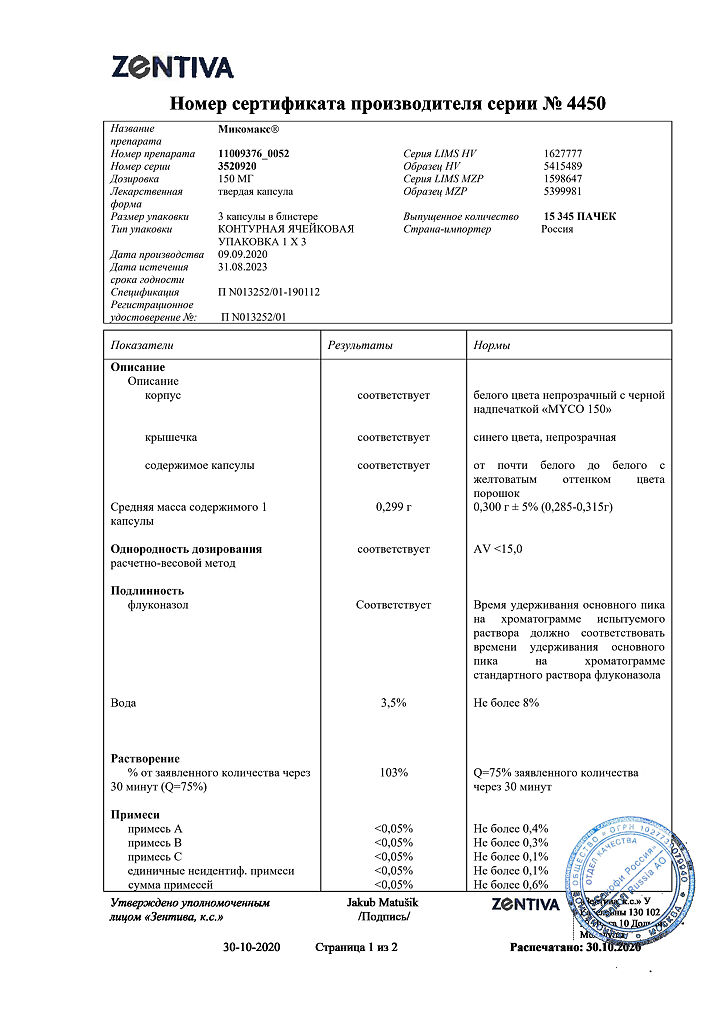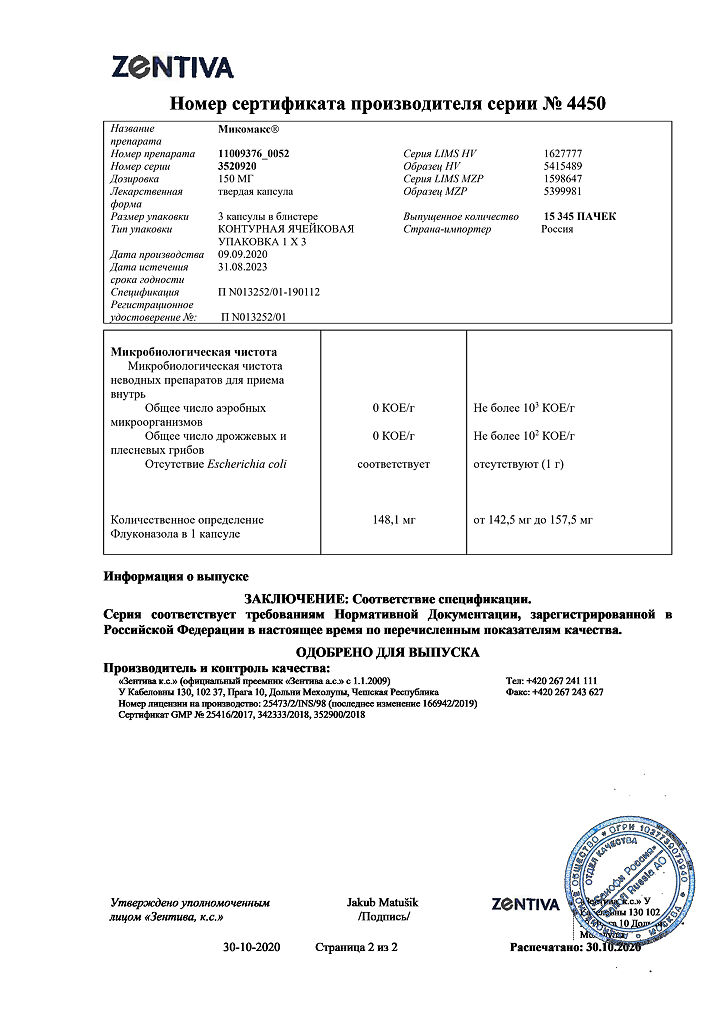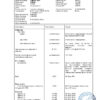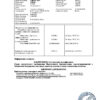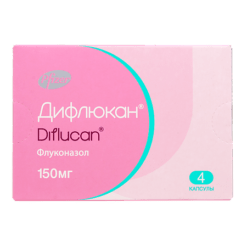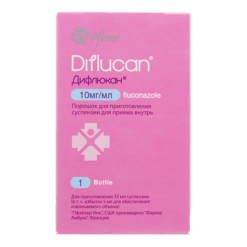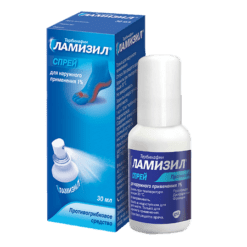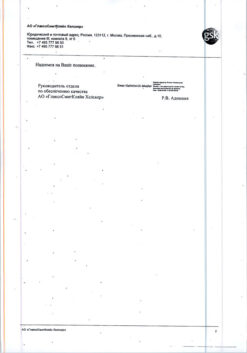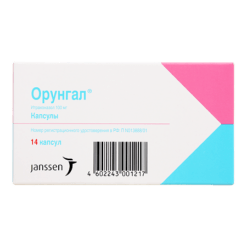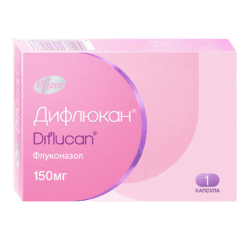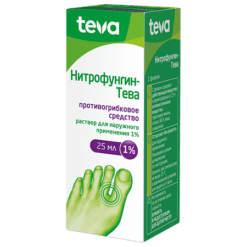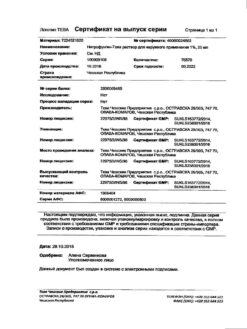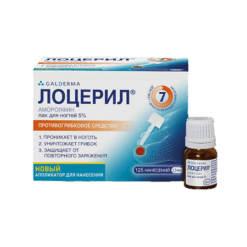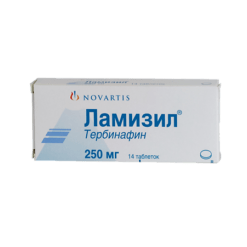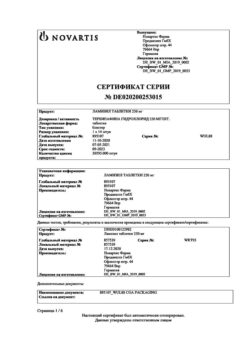No products in the cart.
Mycomax, 150 mg capsules 3 pcs
€13.15 €11.51
Description
MIKOMAX is an antifungal.
Pharmacodynamics
Fluconazole, representative of the class of triazole antifungal agents, is a potent selective inhibitor of sterol synthesis in the fungal cell.
The drug is effective in opportunistic mycoses, including those caused by Candida spp., Cryptococcus neoformans, Microsporum spp., Trichophyton spp. Fluconazole activity has also been shown in models of endemic mycoses, including infections caused by Blastomyces dermatitidis, Coccidiodes immitis and Histoplasma capsulatum.
Pharmacokinetics
Fluconazole is well absorbed after oral administration, its bioavailability is 90%. Cmax after oral administration on an empty stomach at a dose of 150 mg is 90% of plasma content when administered in the IV dose of 2.5-3.5 mg/l. Simultaneous intake of food has no effect on absorption of the drug taken orally. Cmax in plasma is reached 0.5-1.5 hours after administration.
The T1/2 of fluconazole is about 30 hours. Plasma concentrations are in direct proportion to the dose. The 90% level of equilibrium concentration is reached by 4-5 days of treatment with the drug (when taken once daily).
The administration of a shock dose (on the first day), 2 times the usual daily dose, allows to reach the level corresponding to 90% of the equilibrium concentration by the second day. The apparent volume of distribution approaches the total body water content. Binding to plasma proteins is 11-12%.
Fluconazole penetrates well into all body fluids. Concentrations of the drug in saliva and sputum are similar to its levels in plasma. In patients with fungal meningitis the content of fluconazole in the cerebrospinal fluid reaches 80% of its level in plasma.
In the stratum corneum, epidermis, dermis and sweat fluid high concentrations are achieved that exceed serum levels.
Fluconazole is mainly excreted by the kidneys; approximately 80% of the administered dose is excreted unchanged in the urine. Fluconazole clearance is proportional to creatinine clearance. No fluconazole metabolites were detected in peripheral blood.
Indications
Indications
cryptococcosis, including cryptococcal meningitis and other localizations of this infection (including in the lungs, on the skin), both in patients with a normal immune response and with various forms of immunosuppression (including in patients with AIDS, with organ transplantation); the drug can be used to prevent cryptococcal infection in patients with AIDS;
generalized candidiasis, including candidemia, disseminated candidiasis and other forms of invasive candidal infections (infections of the peritoneum, endocardium, eyes, respiratory and urinary tract); candiduria, . Treatment can be carried out in patients with malignant neoplasms, patients in intensive care units, patients undergoing cytostatic or immunosuppressive therapy, as well as in the presence of other factors predisposing to the development of candidiasis;
candidiasis of the mucous membranes, incl. oral cavity and pharynx (including atrophic candidiasis of the oral cavity associated with wearing dentures), esophagus, non-invasive bronchopulmonary candidiasis; prevention of relapse of oropharyngeal candidiasis in patients with AIDS;
genital candidiasis: vaginal candidiasis (acute and chronic recurrent), prophylactic use to reduce the frequency of relapses of vaginal candidiasis (3 or more episodes per year); candidal balanitis;
prevention of fungal infections in patients with malignant neoplasms who are predisposed to such infections as a result of chemotherapy with cytostatics or radiation therapy;
mycoses of the skin, including mycoses of the feet, body, groin area, pityriasis versicolor, onychomycosis; skin candidiasis;
deep endemic mycoses, including coccidioidomycosis, paracoccidioidomycosis, sporotrichosis and histoplasmosis in patients with normal immunity.
Pharmacological effect
Pharmacological effect
MICOMAX – antifungal.
Pharmacodynamics
Fluconazole, a member of the triazole antifungal class, is a powerful selective inhibitor of sterol synthesis in fungal cells.
The drug is effective against opportunistic mycoses, incl. caused by Candida spp., Cryptococcus neoformans, Microsporum spp., Trichophyton spp. Fluconazole has also been shown to be active in models of endemic mycoses, including infections caused by Blastomyces dermatitidis, Coccidiodes immitis and Histoplasma capsulatum.
Pharmacokinetics
After oral administration, fluconazole is well absorbed, its bioavailability is 90%. Cmax after oral administration on an empty stomach at a dose of 150 mg is 90% of the plasma content when administered intravenously at a dose of 2.5–3.5 mg/l. Concomitant food intake does not affect the absorption of the drug taken orally. Cmax in plasma is achieved 0.5–1.5 hours after administration.
T1/2 of fluconazole is about 30 hours. Plasma concentrations are directly proportional to the dose. 90% level of equilibrium concentration is achieved by 4–5 days of treatment with the drug (when taken 1 time/day).
Administration of a loading dose (on the first day), 2 times higher than the usual daily dose, allows you to achieve a level corresponding to 90% of the equilibrium concentration by the second day. The apparent volume of distribution approximates the total body water content. Plasma protein binding is 11–12%.
Fluconazole penetrates well into all biological fluids of the body. Concentrations of the drug in saliva and sputum are similar to its levels in plasma. In patients with fungal meningitis, the fluconazole content in the cerebrospinal fluid reaches 80% of its plasma level.
In the stratum corneum, epidermis, dermis and sweat fluid, high concentrations are reached that exceed serum concentrations.
Fluconazole is excreted primarily by the kidneys; approximately 80% of the administered dose is excreted unchanged in the urine. Fluconazole clearance is proportional to creatinine clearance. No fluconazole metabolites were detected in peripheral blood.
Special instructions
Special instructions
In rare cases, the use of Mycomax was accompanied by a toxic effect on the liver, incl. and with a fatal outcome, mainly in patients with serious concomitant diseases.
During treatment it is necessary to monitor liver function.
If signs of liver damage appear that may be associated with taking fluconazole, the drug should be discontinued.
Active ingredient
Active ingredient
Fluconazole
Composition
Composition
1 capsule contains:
Active substance:
fluconazole 150 mg;
Excipients:
lactose monohydrate;
pregelatinized starch;
colloidal silicon dioxide;
magnesium stearate;
sodium lauryl sulfate.
Contraindications
Contraindications
hypersensitivity to the drug or azole compounds similar in structure;
simultaneous use of terfenadine or astemizole and other drugs that prolong the QT interval;
children’s age (up to 3 years).
With caution: liver and/or renal failure, simultaneous use of potentially hepatotoxic drugs, alcoholism.
Side Effects
Side Effects
From the digestive system: changes in taste, vomiting, nausea, diarrhea, flatulence, abdominal pain, rarely – liver dysfunction (jaundice, hepatitis, hepatonecrosis, hyperbilirubinemia, increased activity of ALT, AST, alkaline phosphatase).
From the nervous system: headache, dizziness, rarely – convulsions.
From the hematopoietic organs: rarely – leukopenia, thrombocytopenia, neutropenia, agranulocytosis.
Allergic reactions: skin rash, rarely – malignant exudative erythema (Stevens-Johnson syndrome), toxic epidermal necrolysis (Lyell’s syndrome), anaphylactoid reactions.
Other: rarely – renal dysfunction, alopecia, hypercholesterolemia, hypertriglyceridemia, hypokalemia.
Interaction
Interaction
When fluconazole is used with warfarin, the PT increases (by an average of 12%). In this regard, it is recommended to carefully monitor PT parameters in patients receiving the drug in combination with coumarin anticoagulants.
Fluconazole increases the plasma half-life of oral hypoglycemic sulfonylurea agents (chlorpropamide, glibenclamide, glipizide, tolbutamide) in healthy people. The combined use of fluconazole and oral hypoglycemic agents in patients with diabetes is allowed, but the doctor must keep in mind the possibility of developing hypoglycemia.
Concomitant use of fluconazole and phenytoin may lead to an increase in plasma phenytoin concentrations to a clinically significant extent. Therefore, if it is necessary to use these drugs together, it is necessary to monitor phenytoin concentrations with dose adjustment in order to maintain drug levels within the therapeutic interval.
The combination with rifampicin leads to a decrease in AUC by 25% and a shortening of T1/2 of fluconazole from plasma by 20%. Therefore, in patients receiving rifampicin at the same time, it is advisable to increase the dose of fluconazole.
It is recommended to monitor the concentration of cyclosporine in the blood in patients receiving fluconazole, because the use of fluconazole and cyclosporine in patients with a kidney transplant (when taking fluconazole at a dose of 200 mg/day) leads to a slow increase in the concentration of cyclosporine in plasma.
Patients who receive high doses of theophylline or who are at risk of developing theophylline toxicity should be monitored for early detection of symptoms of theophylline overdose, because taking fluconazole leads to a decrease in the average rate of clearance of theophylline from plasma.
With the simultaneous use of fluconazole and terfenadine, cisapride, cases of adverse reactions from the heart, including paroxysms of ventricular tachycardia (torsades de pointes), have been described.
Concomitant use of fluconazole and hydrochlorothiazide can lead to an increase in plasma concentrations of fluconazole by 40%.
There are reports of interaction between fluconazole and rifabutin, accompanied by an increase in serum levels of the latter. Cases of uveitis have been described with the simultaneous use of fluconazole and rifabutin. Patients receiving rifabutin and fluconazole simultaneously should be carefully monitored.
In patients receiving a combination of fluconazole and zidovudine, an increase in the concentration of zidovudine is observed, which is caused by a decrease in the conversion of the latter to its main metabolite, so an increase in the side effects of zidovudine should be expected.
Overdose
Overdose
Symptoms: hallucinations, paranoid behavior.
Treatment: symptomatic, gastric lavage, forced diuresis. Hemodialysis within 3 hours reduces plasma concentrations by approximately 50%.
Storage conditions
Storage conditions
Store out of reach of children, in a dry, dark place at a temperature of 10 to 25°C.
Shelf life
Shelf life
3 years.
Manufacturer
Manufacturer
Zentiva k.s., Czech Republic
Additional information
| Shelf life | 3 years. |
|---|---|
| Conditions of storage | Keep out of reach of children, dry, protected from light, at 10 to 25°C. |
| Manufacturer | Zentiva k.s., Czech Republic |
| Medication form | capsules |
| Brand | Zentiva k.s. |
Related products
Buy Mycomax, 150 mg capsules 3 pcs with delivery to USA, UK, Europe and over 120 other countries.

